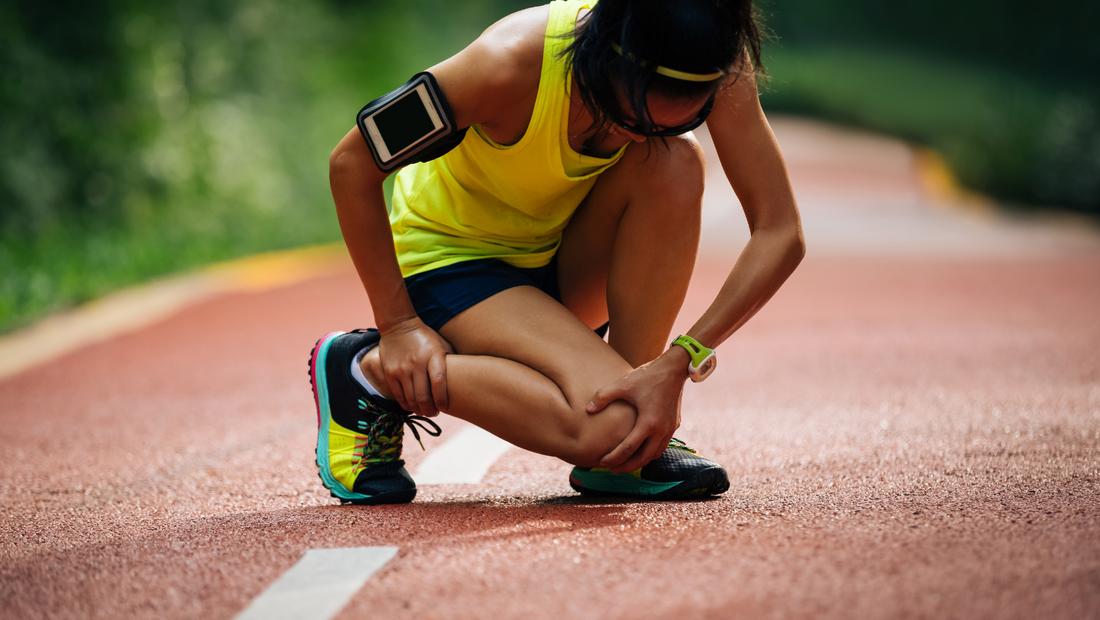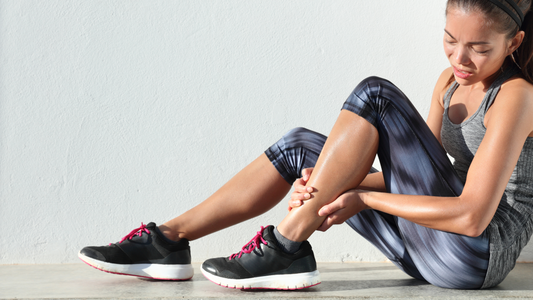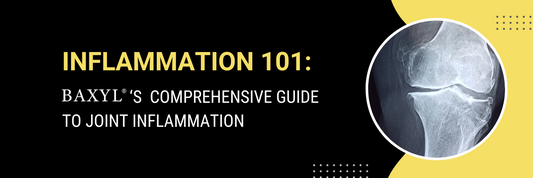Any athlete knows the emotional range of victories and defeat. They also know that perhaps the most emotionally and physically draining defeat is a sport injury. A sport injury causes setbacks that nobody wants to think about, and if you are a valuable part of a team, your team feels the impact too.
The Baxyl® Team knows it is no good when one of your valuable team players is down and out with a sport injury. That is why we have created this blog to help you learn about our amazing products, powered by industry-leading MHB3® Hyaluronan.

Recover Faster from a Sport Injury
Baxyl® Sport offers the research-proven joint recovery and health benefits of original Baxyl®, but with astaxanthin to help support a natural inflammatory response and improve exercise recovery. Athletes recover faster with Baxyl Sport!
Baxyl Sport is formulated with a natural hyaluronic acid (HA) formula bioidentical to the hyaluronic acid naturally produced by the body. It is unique to other hyaluronic supplements on the market due to its oral liquid formulation, which allows Baxyl Sport to absorb quickly and efficiently with long-term results.
The ingredients in Baxyl Sport are designed to improve joint performance and recovery time. Its high-molecular weight hyaluronic acid helps to improve joint mobility and flexibility, naturally restore joint tissues and cartilage, promotes tissue hydration and supports healthy bone formation as well as spine and vertebrae health.
84% of research participants felt a result with the use of Baxyl Sport’s primary ingredient – MHB3® Hyaluronan – within in 21 days*. Research-proven benefits of Baxyl Sport include:
- Healthy Inflammatory Response
- Joint, Tissue, and Cartilage Health
- Exercise Recovery and Performance

More about MHB3® Hyaluronic Acid
MHB3® Hyaluronan is a proprietary hyaluronic acid ingredient found in all Baxyl products. It has been scientifically proven to confer greater and more consistent results than any other product on the market for both short- and long-term joint care. MHB3® supplements the body with much needed hyaluronic acid (HA) while stimulating CD44 and RHAMM receptors (which are responsible for natural hyaluronic acid production) upon ingestion.
This means that MHB3 supplementation from products like Baxyl and Baxyl Sport stimulates the natural HA feedback loop when Baxyl is ingested. The liquid nature of MHB3 is proven to be absorbed 3.8 times better by the body than dry hyaluronic acid forms such as tablets, powders or capsules. MHB3® has been awarded eight U.S. Patents for joint health and is highly researched to be efficacious, allowing for best results (Hefner, 2012).

Common Causes of Sport Injury
A sport injury can occur due to a variety of factors, including biomechanical, environmental and behavioral factors. Here are some common causes of sports injuries:
Trauma or Impact
Direct trauma or impact, such as collisions, falls or contact with another player or object, can result in a sport injury. This includes injuries like fractures, sprains, strains and contusions.

Overuse or Repetitive Stress
Overuse or repetitive stress on muscles, tendons, ligaments and joints can lead to sports injuries, particularly in activities that involve repetitive motions or high-impact movements. Examples include runner’s knee, tennis elbow, swimmer’s shoulder, jumper’s knee, stress fractures and tendinitis.
Poor Technique or Form
Incorrect or poor technique while performing sports-related movements can increase the risk of injury. Improper body mechanics, technique errors, or faulty equipment usage can lead to strains, sprains, and other musculoskeletal injuries.
Muscle Imbalances
Muscle imbalances, weakness or asymmetries in strength or flexibility between opposing muscle groups can predispose athletes to injuries. Imbalances in muscle strength, flexibility or stability can lead to compensatory movements and increased injury risk.
Inadequate Warm-up or Cool-down
Failing to properly warm up before engaging in physical activity or cool down afterward can increase the risk of a sport injury. Warm-up exercises help prepare the body for activity by increasing blood flow, flexibility and muscle readiness. The cool-down exercises aid in recovery and reduce muscle soreness.
Fatigue or Overtraining
Fatigue, overtraining or insufficient rest between workouts can contribute to sports injuries. Some athletes can struggle with overtraining syndrome, a condition caused by excessive training volume, intensity or frequency without adequate recovery time. This can lead to physical and mental fatigue, decreased performance and increased injury risk.
Environmental Factors
Some causes of injury are outside our control. Environmental conditions such as extreme temperatures, humidity, altitude or terrain can impact injury risk during sports activities. Heat-related illnesses, dehydration, cold injuries and environmental hazards can pose additional challenges and increase injury risk.
Equipment Issues
Equipment-related factors, such as improper fit, wear and tear or equipment malfunction, can contribute to sports injuries. Wearing inadequate or poorly fitting footwear, protective gear or safety equipment can increase the risk of falls, impact injuries, or accidents.
Age & Developmental Factors
Age-related factors, growth spurts and developmental stages can influence injury risk in athletes. Children and adolescents may be more susceptible to growth-related injuries such as Osgood-Schlatter disease or Sever’s disease due to skeletal growth and development.
Previous Injury History
A history of previous injuries or musculoskeletal issues can increase the risk of recurrent injuries or ongoing problems in athletes. Inadequate rehabilitation, premature return to activity or underlying biomechanical issues may contribute to chronic or recurring injuries.
By understanding these common causes of sports injuries, athletes, coaches and healthcare professionals can implement injury prevention strategies, address risk factors and promote safe and effective participation in sports and physical activity. Proper training, technique, conditioning, equipment uses, and injury management are essential components of injury prevention and athlete safety.
Inflammation’s Role in Sport Injury
Inflammation plays a crucial role in the body’s response to sports injuries, serving as both a protective and reparative mechanism. However, excessive or prolonged inflammation can also contribute to tissue damage, pain and delayed recovery. Here are 8 ways inflammation impacts sports injuries:
Initiation of Healing Process
Inflammation is the body’s initial response to tissue injury, serving as a protective mechanism to initiate the healing process. When sports-related trauma occurs, damaged cells release pro-inflammatory mediators, such as cytokines, chemokines and prostaglandins, which attract immune cells to the site of injury.
Following a sports injury, the body initiates an acute inflammatory response as part of the natural healing process. Inflammation helps mobilize immune cells, blood vessels and biochemical mediators to the site of injury, promoting tissue repair and removal of damaged cells and debris.

Pain & Swelling
Inflammatory mediators such as prostaglandins, cytokines and histamine contribute to the characteristic symptoms of inflammation, including pain, swelling, redness and warmth. While these symptoms are part of the body’s protective response, they can also contribute to discomfort and functional impairment following a sports injury.
Immune Response
Inflammation recruits immune cells such as neutrophils, macrophages, and lymphocytes to the injured tissue to remove pathogens, debris, and damaged cells. Immune cells play a critical role in clearing away debris and initiating the repair process, but excessive immune activity can also contribute to tissue damage and inflammation.
Tissue Repair & Regeneration
Inflammation triggers the release of growth factors, cytokines and other signaling molecules that promote tissue repair, remodeling and regeneration. Fibroblasts lay down new collagen fibers, and endothelial cells form new blood vessels to support tissue healing and regeneration.
Resolution of Inflammation
In a healthy healing process, inflammation gradually resolves as the injured tissue is repaired and regenerated. Anti-inflammatory mediators help dampen the inflammatory response, while specialized immune cells, such as regulatory T cells, help promote tissue healing and restore homeostasis.
Chronic Inflammation & Delayed Healing
In some cases, inflammation may become chronic or dysregulated, leading to prolonged tissue damage, delayed healing and persistent pain. Chronic inflammation can impair tissue repair processes, intensifies tissue degeneration, and increase the risk of recurrent injuries.

Impact on Performance
Inflammation and pain associated with sports injuries can impact athletic performance by limiting range of motion, strength, flexibility and endurance. Pain and discomfort may also affect psychological factors such as motivation, confidence and mood, further influencing performance outcomes.
Management Strategies
Effective management of inflammation is essential for promoting optimal recovery and return to sport following an injury. Treatment strategies may include:
- rest, ice, compression, elevation (RICE)
- nonsteroidal anti-inflammatory drugs (NSAIDs)
- physical therapy
- massage
- acupuncture
There are also a variety of other modalities that can help reduce inflammation, relieve pain and facilitate tissue healing. If you’re curious about what else can be done to tackle joint inflammation from a sport injury, contact your primary healthcare provider.
Overall, inflammation plays a complex and dynamic role in the body’s response to sports injuries, influencing both the protective and reparative aspects of tissue healing. Understanding the role of inflammation in sports injury is essential for developing effective injury management and rehabilitation strategies to support optimal recovery and return to sport.
Become a Baxyl® Believer
Here’s the review that one customer, Sherry G., left on our website:
“My chiropractor recommended Baxyl Sport after I complained about my creaky knees. I am training for a decathlon and use my joints a lot. Recently, my legs have been feeling like they are 10 years younger again! I would recommend this product for cyclists, runners or anyone who take fitness seriously as a lifestyle choice”
The benefits of Baxyl products are guaranteed by our manufacturer within the first 21 days of use at the recommended dosage or your money back! If you do not feel relief or results within three weeks of supplementation and the suggested dosage, bring back your bottle of Baxyl to the place of purchase (opened or unopened) to receive a full refund from our Customer Service team.

Get your Baxyl® Sport Today!
Order Baxyl Sport from the comfort of your own home. Or if you prefer to shop locally and support small businesses, we’ve got you covered. Our products are available at local retail outlet stores, including health markets and chiropractors. Find a retailer here.

Stay Informed About Your Joint Health
Have any questions? Want to stay up to date on the best methods to relieve knee pain with our regular newsletters? Sign up now!





